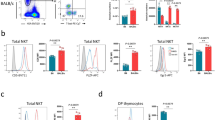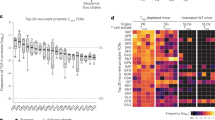Abstract
IMMUNE functions depend largely on the activities of peripheral lymphocytes which have been ‘processed’ in the thymus (T cells). The best characterised activities of these cells, such as in vitro cytotoxicity and suppressor and helper capacities in adoptive immunisations seem to be mediated by distinct subpopulations. However, it has emerged that T cells of all subpopulations exhibit a dual recognition faculty, on the one hand, towards entities coded by the major histocompatibility gene complex (MHC). and on the other towards foreign antigens. Without appropriate MHC recognition ‘foreignness’ may not be noticed, giving rise in various functional assays to what has been termed MHC restriction. For example, in the mouse, T cells may lack cytotoxicity unless they have H–2 region gene products1, in common with their target cells. T cells which ‘help’ in antibody responses can only do so fully if the B cells with which they are cooperating have similar I-region coding2. These various restrictions were thought to represent the need for interaction of like substances on cell surfaces perhaps to establish propinquity before any subsequent interactions could be initiated. Recently, however, it has been demonstrated3,4 that irradiated bone marrow chimaeras of the type A + B → (A × B)F1 possessed populations of T cells of A and B origin each of which was capable of interacting with B-cell populations of both A and B origin (A and B are used here purely as symbols for MHC-disparate mouse strains). Thus it seemed whatever the genetic determinacy of the cell, it could, when appropriately conditioned, establish reactions based on identity with either genetically similar or genetically different cells2,5. The exact nature of this conditioning began to emerge from experiments of Bevan6 and Zinkernagel7 who found that T cells from (A × B)F1 → A chimaeras could only kill target cells bearing A type MHC determinants, whilst no cytotoxicity towards B targets was possible. Comparable studies gave analogous results for helper T cells8,9 and recently, it was shown that the events which seem to determine the pattern of H–2 restricted specifities of the T cells concerned with cytotoxicity occur within the thymus gland7. We now show that intrathymic conditioning also determines the restriction specificities of T cells involved in helping antibody production.
This is a preview of subscription content, access via your institution
Access options
Subscribe to this journal
Receive 51 print issues and online access
$199.00 per year
only $3.90 per issue
Buy this article
- Purchase on Springer Link
- Instant access to full article PDF
Prices may be subject to local taxes which are calculated during checkout
Similar content being viewed by others
References
Zinkernagel, R. M. & Doherty, P. C. Nature 251, 547–548 (1974).
Katz, D. H. & Benacerraf, B. in The Role of Products of the Histocompatibility Gene Complex in Immune Responses (eds Katz, D. H. & Benacerraf, B.). 355–400 (Academic, New York, 1976).
von Boehmer, H., Hudson, L. & Sprent, J. J. exp. Med. 142, 989–997 (1975).
Waldmann, H., Pope, H. & Munro, A. J. Nature 258, 728–730 (1975).
Waldmann, H. Immun. Rev. 35, 121–145 (1977).
Bevan, M. J. J. exp. Med. 142, 1349–1350 (1977).
Zinkernagel, R. M. et al. J. exp. Med. 147, 897–908 (1978).
Waldmann, H., Pope, H., Brent, L. & Bighouse, K. Nature 274, 166–167 (1978).
Sprent, J. J. exp. Med. 147, 1838–1840 (1978).
Dukor, P., Miller, J. F. A. P., House, W. & Allman, V. Transplantation 3, 639–668 (1965).
Hays, E. F. & Alpert, P. F. J. exp. Med. 130, 847–857 (1969).
Urso, P. & Gengozian, N. J. Immun. 113, 1170–1179 (1974).
Munro, A. J. & Waldmann, H. Br. med. Bull. 34, 253–258 (1978).
Von Boehmer, H., Haas, W. & Jerne, N. K. Proc. natn. Acad. Sci. U.S.A. 75, 2439–2442.
Author information
Authors and Affiliations
Rights and permissions
About this article
Cite this article
WALDMANN, H., POPE, H., BETTLES, C. et al. The influence of thymus on the development of MHC restrictions exhibited by T-helper cells. Nature 277, 137–138 (1979). https://doi.org/10.1038/277137a0
Received:
Accepted:
Published:
Issue Date:
DOI: https://doi.org/10.1038/277137a0
This article is cited by
-
A one-receptor view of T-cell behaviour
Nature (1981)
-
Lymphocyte differentiation and major histocompatibility complex antigen expression in the embryonic thymus
Nature (1980)
-
T cell recognition of antigen in vivo: Role of the H-2 complex
Springer Seminars in Immunopathology (1980)
Comments
By submitting a comment you agree to abide by our Terms and Community Guidelines. If you find something abusive or that does not comply with our terms or guidelines please flag it as inappropriate.



